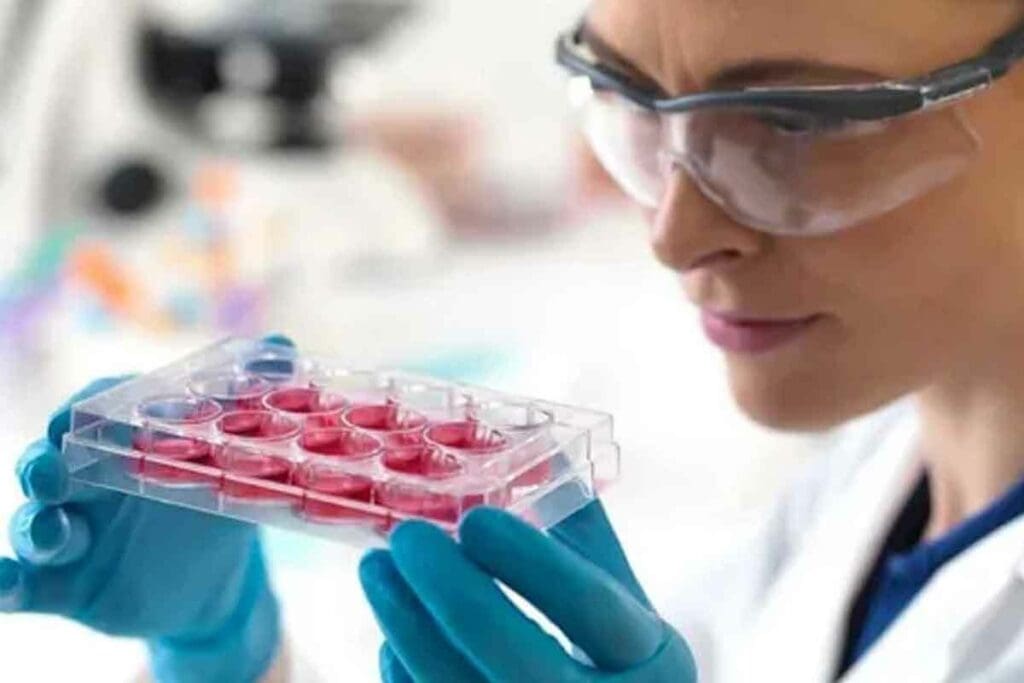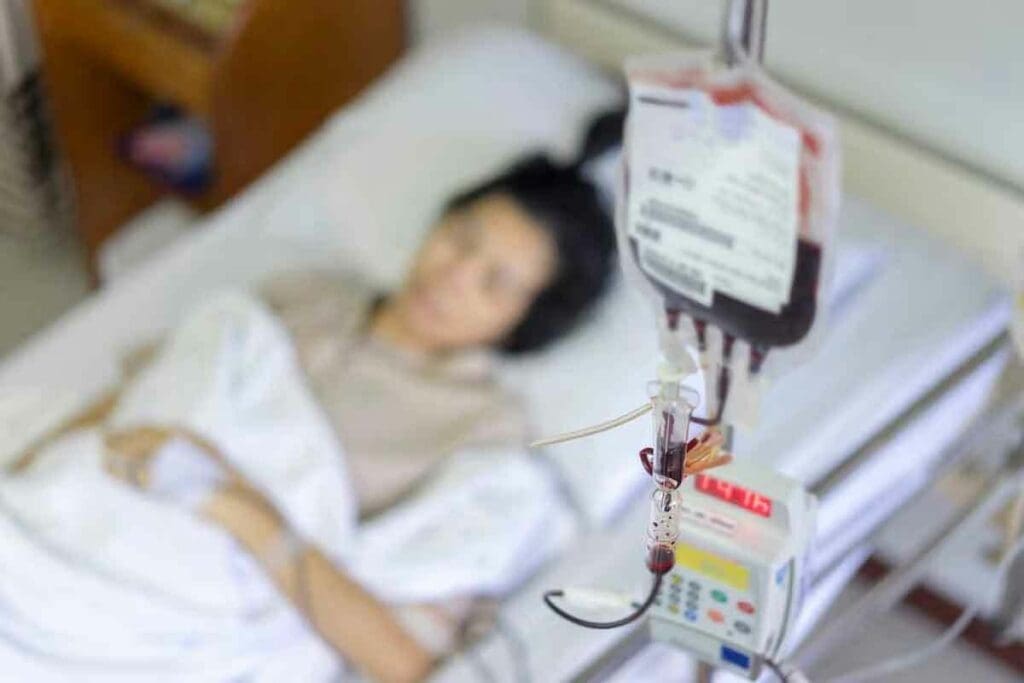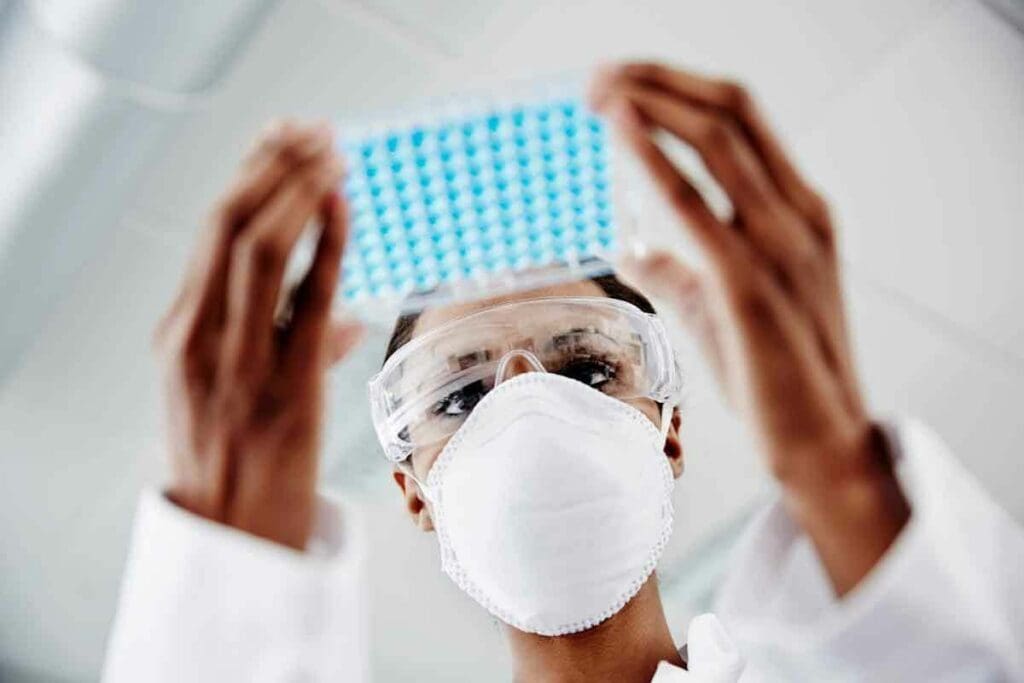Last Updated on November 14, 2025 by Ugurkan Demir

Allogeneic cell transplantation is a complex medical procedure. It offers new hope for patients with serious blood disorders. This treatment involves moving healthy stem cells from a donor to a recipient. It can cure life-threatening conditions.
Finding a suitable donor is the first step. This shows how important donor matching is for a successful transplant. By learning about the allogeneic cell transplantation process, patients can understand their treatment options better.

Allogeneic hematopoietic stem cell transplantation (HSCT) is a medical treatment. It replaces a patient’s sick bone marrow with healthy donor stem cells. This helps restore normal blood and immune system functions.
This procedure is a lifesaving option for serious diseases. It’s used for certain blood cancers and disorders.
Allogeneic cell transplantation moves stem cells from a donor to a recipient. “Allogeneic” means the cells come from a genetically different person of the same species. Hematopoietic stem cells are key because they can turn into all blood cell types.
The main goal is to replace the recipient’s sick bone marrow. This way, the recipient gets healthy stem cells. This helps restore a normal blood and immune system.
There are different types of allogeneic transplants. They’re based on where the donor cells come from and the genetic link between donor and recipient. The main types are:
Allogeneic stem cell transplants can use cells from blood, bone marrow, or umbilical cord blood. The choice depends on the recipient’s health, donor availability, and transplant needs.

Allogeneic transplants are a key treatment for serious diseases. They replace a patient’s sick bone marrow with healthy stem cells from a donor. This can cure or manage many severe illnesses.
Allogeneic transplants are mainly used for blood cancers and disorders. Conditions like acute leukemia, aplastic anemia, and myelodysplastic syndromes can be treated. This treatment can help patients by getting rid of cancer cells and making their bone marrow healthy again.
Allogeneic transplants also help with other serious health issues. This includes some genetic disorders and severe autoimmune diseases. Their ability to treat a wide range of conditions makes them vital in today’s medicine.
Allogeneic cell transplantation uses hematopoietic stem cells and the immune system. It replaces a patient’s sick or damaged cells with healthy ones from a donor.
Hematopoietic stem cells make all blood cells, like white and red blood cells, and platelets. They can grow and change into different cell types. This makes them key for allogeneic cell transplantation.
The donor’s stem cells are first collected, often from bone marrow or blood. Then, they are given to the patient. There, they start making new blood cells in the bone marrow.
| Cell Type | Function | Role in Transplantation |
| White Blood Cells | Fight infections | Reconstitute the immune system |
| Red Blood Cells | Carry oxygen | Restore oxygen delivery to tissues |
| Platelets | Prevent bleeding | Support clotting and wound healing |
The immune system is critical for allogeneic cell transplantation. The donor’s immune cells can fight the patient’s cancer cells. This is called the graft-versus-tumor effect.
But the immune system can also cause problems. For example, graft-versus-host disease (GVHD) happens when the donor’s cells attack the patient’s healthy tissues. To avoid this, matching the donor carefully is very important. The Allogeneic Transplant Clinic helps with this.
Understanding hematopoietic stem cells and the immune system helps doctors manage allogeneic cell transplantation better. This improves how well patients do after the transplant.
Finding the right donor is key to allogeneic cell transplantation success. This involves several important steps to find the best match for the recipient.
The Human Leukocyte Antigen (HLA) typing and matching are vital. HLA typing tests the proteins on white blood cells to find genetic markers. A close HLA match lowers the risk of graft-versus-host disease (GVHD).
HLA matching looks for family members or unrelated donors in registries. The aim is to find a donor with HLA markers similar to the recipient’s.
Donor cells come from different sources. Family members are often the first choice for a close HLA match. If not available, the search goes to unrelated donor registries.
Cells can be taken from bone marrow, peripheral blood, or umbilical cord blood. The choice depends on the recipient’s needs and the donor’s health.
Finding a compatible donor can take up to 12 weeks. This includes HLA typing, donor screening, and cell collection. The time varies based on donor availability and HLA matching complexity.
After finding a donor, the transplant team prepares the cells for the transplant.
The pre-transplant phase is key for those waiting for an allogeneic cell transplant. It gets the body ready for the transplant. This phase includes several steps to make sure the recipient is as healthy as possible for the transplant.
Before the transplant, patients get a full medical check-up. This check-up looks at their health and finds any problems that might make the transplant harder. It includes looking at their medical history, a physical exam, and tests like blood work and imaging.
Key assessments during medical evaluations include:
When the donor’s stem cells are taken from the blood, a mobilization process is used. This process gets stem cells from the bone marrow into the blood. It uses medicines to help make more stem cells.
Conditioning regimens prepare the body for the transplant. They kill cancer cells and weaken the immune system. These regimens often include chemotherapy and sometimes radiation therapy.
| Component | Purpose |
| Chemotherapy | Destroy cancer cells and suppress the immune system |
| Radiation Therapy | Kill cancer cells and further suppress the immune system |
Knowing about pre-transplant preparation helps patients understand this important phase. It prepares them for the transplant process.
It’s important for patients and healthcare providers to know the steps of allogeneic cell transplantation. This process includes stem cell collection, infusion, and post-transplant care.
Stem cells can be taken from the donor’s blood or bone marrow. This is done through apheresis or bone marrow harvest. Apheresis uses medicine to move stem cells into the blood. Then, a special device collects these cells from the blood.
After collecting the stem cells, they are given to the recipient through an IV. This usually takes a few hours and is mostly painless. The stem cells then go to the bone marrow to make new blood cells.
“The infusion process is a critical step in the allogeneic cell transplantation procedure, requiring careful monitoring to ensure the recipient’s safety and the success of the transplant.”
On transplant day, patients get the infusion in a hospital or clinic. The medical team watches for any bad reactions. Patients are told to rest and drink lots of water after the infusion.
Knowing the steps of allogeneic cell transplantation helps patients prepare for this treatment.
The journey to recovery after an allogeneic stem cell transplant is complex. It includes engraftment and long-term care. This phase is key to patients’ success and health.
Engraftment starts when the transplanted stem cells make new blood cells. This usually happens in 2-4 weeks after the transplant. Patients watch for signs like rising white blood cell counts.
A good engraftment means the new stem cells are working right. For more info on the allogeneic stem cell transplantation process, check out specialized resources.
The time in the hospital after transplant varies. It depends on the patient’s health and the transplant details. Usually, patients stay a few weeks to manage risks and check engraftment.
In the hospital, the medical team watches the patient closely. They handle side effects and give needed care. Below is a typical recovery timeline and what’s monitored during the stay.
| Week | Monitoring Activities | Expected Outcomes |
| 1-2 | Daily blood count monitoring, infection surveillance | Initial engraftment signs, managing infections |
| 2-4 | Continued blood count monitoring, GVHD surveillance | Stable engraftment, GVHD management |
After leaving the hospital, patients start long-term care. They see their healthcare provider regularly. This is to check their health, manage transplant effects, and adjust meds.
Long-term care is vital for patients’ ongoing health. It helps manage any transplant complications.
Allogeneic transplantation saves lives but comes with big risks like graft-versus-host disease and infections. It’s key to manage these issues well for a successful transplant.
Graft-versus-host disease happens when the donor’s immune cells attack the recipient’s body. It can be mild or severe. Acute GVHD shows up early, while chronic GVHD can hit later and affect more areas.
To fight GVHD, doctors use drugs to calm down the donor’s immune cells. Catching it early and treating it fast is vital to avoid lasting harm.
After an allogeneic transplant, infections are a big worry because the immune system is weak. Patients face risks from bacteria, viruses, and fungi. To prevent this, doctors use antibiotics, antivirals and keep patients away from germs.
Watching for infection signs and treating them quickly is a must. Even as the immune system gets stronger, infection risks stay high during the first few months.
Allogeneic cell transplantation, or allogeneic stem cell transplant, is a complex medical procedure. It offers a life-saving treatment for various blood cancers and disorders. By understanding the allogeneic transplant, patients can better navigate the process. This helps them make informed decisions about their care.
The benefits of allogeneic cell transplantation are many. Hematopoietic stem cell transplantation (HSCT) has been shown to cure some life-threatening disorders. It gives patients a new lease on life. The procedure involves replacing a patient’s damaged or diseased stem cells with healthy ones from a donor.
By grasping the allogeneic cell transplantation benefits, patients can appreciate the significance of this treatment. As medical research continues to advance, the field of HSCT is evolving. This offers new hope for patients in need of an allogeneic stem cell transplant.
Allogeneic hematopoietic stem cell transplantation is a medical procedure. It uses stem cells from a donor to treat blood-related disorders and cancers in a patient.
Bone marrow transplants replace a patient’s damaged bone marrow with healthy stem cells. These stem cells can come from the patient themselves or a donor.
Allogeneic stem cell transplantation uses stem cells from a donor. Autologous stem cell transplantation uses the patient’s own stem cells.
Allogeneic transplants treat blood cancers and disorders like leukemia and lymphoma. They also treat genetic disorders.
A compatible donor is found through HLA typing and matching. This involves testing the patient’s and donor’s HLA genes to find a match.
Confirming a donor match can take up to 12 weeks. This depends on the search complexity and donor availability.
GVHD is a complication of allogeneic transplantation. It occurs when the donor’s immune cells attack the patient’s tissues and organs.
GVHD is managed with immunosuppressive medications. These treatments help reduce complications and promote graft tolerance.
Allogeneic transplants carry risks like GVHD, infection, and organ damage. These risks are managed through monitoring and supportive care.
The immune system is key in allogeneic transplantation. It affects graft acceptance or rejection and GVHD risk.
Hematopoietic stem cells produce blood cells. In allogeneic transplantation, they replace the patient’s damaged or diseased bone marrow.
Subscribe to our e-newsletter to stay informed about the latest innovations in the world of health and exclusive offers!